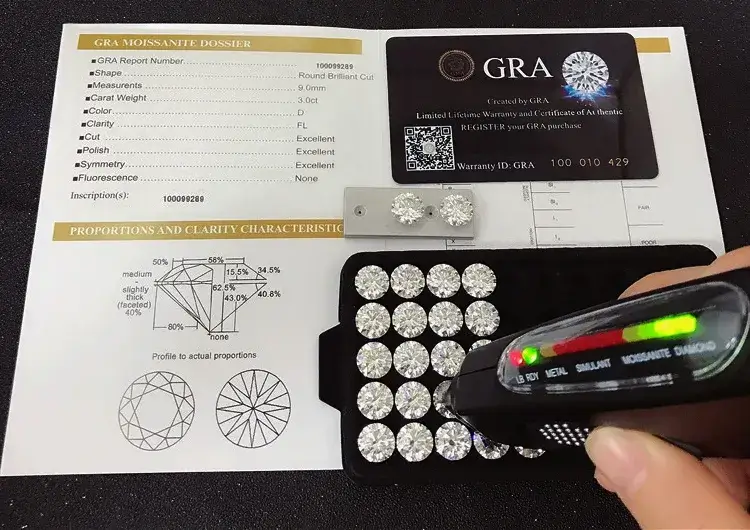
Is Moissanite as Good as a Diamond?
When it comes to selecting a precious gemstone for engagement rings or other fine jewelry, the choice between moissanite and diamond often arises. Both gems offer stunning beauty, but they differ in several key aspects. This comprehensive guide explores whether moissanite is as good as a diamond, examining factors such as brilliance, durability, cost, ethical considerations, and more.
1. Understanding Moissanite and Diamond
Moissanite:
– Composition: Moissanite is composed of silicon carbide. It was originally discovered in a meteor crater and is now lab-created to ensure consistency and quality.
– Brilliance and Fire: Moissanite has a higher refractive index (2.65) than diamond (2.42), resulting in more brilliance and fire (the dispersion of light into colors).
Diamond:
– Composition: Diamonds are made of pure carbon, formed under extreme pressure and heat over billions of years.
– Brilliance and Fire: Diamonds are known for their exceptional brilliance and fire, contributing to their timeless appeal and desirability.
2. Brilliance and Fire
Moissanite:
– Moissanite’s higher refractive index gives it more brilliance and fire than diamonds. This means moissanite sparkles more intensely and disperses more light into spectral colors.
Diamond:
– While diamonds have slightly less brilliance than moissanite, their sparkle is often considered more classic and subtle. Diamonds reflect white light exceptionally well, creating a beautiful, elegant shine.
3. Durability
Moissanite:
– Hardness: Moissanite scores 9.25 on the Mohs scale of hardness, making it extremely durable and resistant to scratching.
– Toughness: It is also known for its toughness, meaning it can withstand daily wear without chipping or breaking.
Diamond:
– Hardness: Diamonds score a perfect 10 on the Mohs scale, making them the hardest known natural material.
– Toughness: Diamonds are very durable, but they can still be chipped or fractured if subjected to a hard blow.
4. Cost
Moissanite:
– Moissanite is significantly more affordable than diamonds. A high-quality moissanite gemstone can cost up to 90% less than a comparable diamond.
Diamond:
– Diamonds are much more expensive, with prices varying greatly based on the 4 Cs (Carat, Cut, Color, and Clarity).
5. Appearance
Moissanite:
– Moissanite can appear slightly different from diamonds in terms of color and brilliance. It often has a warmer tone and a more intense sparkle, especially in larger stones.
Diamond:
– Diamonds are prized for their classic look and ability to reflect light in a way that is unmatched by any other gemstone.
6. Ethical Considerations
Moissanite:
– As a lab-created gemstone, moissanite is a conflict-free choice, ensuring no ethical concerns related to mining practices.
Diamond:
– Natural diamonds can sometimes be associated with ethical issues, such as conflict or “blood” diamonds. However, many diamonds today are certified conflict-free, and lab-grown diamonds offer an ethical alternative.
7. Investment Value
Moissanite:
– Moissanite does not hold the same investment value as diamonds. While it is a beautiful and durable gemstone, it is not considered an asset that will appreciate over time.
Diamond:
– Diamonds are often viewed as an investment. High-quality diamonds can retain or even increase in value, making them a potential asset.
8. Customization and Availability
Moissanite:
– Moissanite is available in a variety of shapes and sizes, and it can be customized to fit any design. Its affordability allows for larger stones or more intricate designs within a given budget.
Diamond:
– Diamonds also offer a wide range of shapes, sizes, and customization options. They are the traditional choice for engagement rings and fine jewelry, providing a timeless appeal.
9. Environmental Impact
Moissanite:
– The environmental impact of creating lab-grown moissanite is generally lower than that of mining natural diamonds. However, the energy used in lab creation processes should also be considered.
Diamond:
– Diamond mining has a significant environmental impact, including habitat destruction and resource consumption. Lab-grown diamonds offer a more environmentally friendly option.
Conclusion: Is Moissanite as Good as a Diamond?
The answer to whether moissanite is as good as a diamond depends on personal preferences and priorities. Here’s a quick summary to help you decide:
– Brilliance and Fire: Moissanite offers more intense sparkle and fire than diamonds.
– Durability: Both are very durable, but diamonds are slightly harder.
– Cost: Moissanite is much more affordable than diamonds.
– Ethics: Moissanite is conflict-free and generally has a lower environmental impact.
– Appearance: Diamonds have a classic look and more subtle brilliance, while moissanite has a warmer tone and intense sparkle.
– Investment: Diamonds hold investment value, whereas moissanite does not.
Ultimately, moissanite is an excellent choice for those seeking a beautiful, durable, and affordable alternative to diamonds, especially if ethical and environmental considerations are important. Diamonds, on the other hand, remain the traditional symbol of luxury and romance, with unmatched investment potential and timeless appeal. Consider what factors matter most to you and make a choice that reflects your values and preferences.
